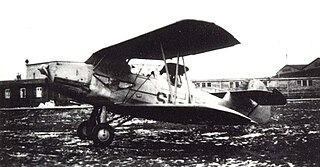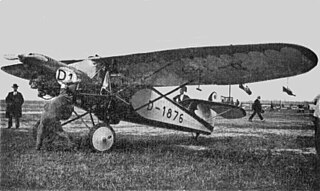
The Arado Ar 68 was a German single-seat biplane fighter developed in the mid-1930s. It was among the first fighters produced when Germany abandoned the restrictions of the Treaty of Versailles and began rearming.

The Arado Ar 231 was a lightweight floatplane, developed during World War II in Germany as a scout plane for submarines by Arado. The need to be stored inside the submarine necessitated compromises in design that made this single-seat seaplane of little practical use.

The Arado Ar 65 was the single-seat biplane fighter successor to the Ar 64. Both looked very similar. The only major difference was the use of a 12-cylinder inline engine versus the Ar 64's radial. The wingspan was also increased.

The Arado Ar 66 was a German single-engined, two-seat training biplane, developed in 1933. It was also used for night ground-attack missions on the Eastern Front. It was engineer Walter Rethel's last design in collaboration with Arado, before Walter Blume, assigned as Arado Flugzeugwerke's chief design engineer in 1933, took over the bulk of the Arado firm's design duties.

The Fieseler Fi 167 was a 1930s German biplane torpedo and reconnaissance bomber designed for use from the Graf Zeppelin class aircraft carriers under construction from 1936 to 1942.

The Arado Ar 197 was a German World War II-era biplane, designed for naval operations for the never-completed German aircraft carrier Graf Zeppelin. Only a few prototypes were built; the project was abandoned in favour of the Messerschmitt Bf 109T and Me 155.

The Arado 95 was a single-engine reconnaissance and patrol biplane designed and built by the German firm Arado in the late 1930s. Ordered by Chile and Turkey, a number were taken over by the Kriegsmarine when World War II started.
The Arado Ar 195 was a single-engine prototype carrier-based torpedo bomber, built by the German firm Arado for service on the German aircraft carrier Graf Zeppelin, during World War II.

The Arado Ar 76 was a German aircraft of the 1930s, designed as a light fighter with a secondary role as an advanced trainer in mind.
The Arado L I was a two-seat parasol-wing sport monoplane built in Germany in 1929, in order to compete in the Europa Rundflug that year. During the fuel consumption trials, the L 1 made a forced landing and was disqualified from the contest. Bringing the aircraft back to Paris, designer Hermann Hofmann performed some aerobatics over the airfield and was killed when it crashed.

The Arado L II was a 1920s German two-seat, high-wing touring monoplane.

The Arado S I was a biplane trainer built in Germany in 1925. The first of three prototypes was powered by a Bristol Lucifer radial engine, while the other two Arado S.Ia aircraft were fitted with the Siemens-Halske Sh 12. The Siemens-Halske Sh 11 powered the Arado S III, a virtually identical aircraft of which only a single prototype was constructed and sold to Turkey.
The Arado SC II was a biplane trainer, developed in Germany in the 1920s. It was based heavily on the SC I, with a more powerful BMW Va engine. Ten examples were built for the Deutsche Verkehrsfliegerschule.
The Arado SD I was a fighter biplane, developed in Germany in the 1920s. It was intended to equip the clandestine air force that Germany was assembling at Lipetsk. The layout owed something to designer Walter Rethel's time with Fokker. Of conventional configuration, the SD I featured a welded steel tube frame, metal-covered ahead of the cockpit, and fabric-covered aft of it. The wooden sesquiplane wings were braced with N-type interplane struts, without any wires - a typical Fokker feature.
The Arado SD II was a fighter biplane developed in Germany in the 1920s. Like the preceding SD I, it was intended to equip the clandestine air force that Germany was assembling at Lipetsk and was hoped to overcome the shortcomings of that type. Although it shared the same basic configuration, the SD II was an all-new design. A considerably larger and heavier aircraft, it had wings of less stagger, braced with conventional wires. The landing gear and tailplane were of far stronger construction.

The Arado SSD I was a biplane fighter seaplane developed in Germany in 1930, intended to be launched from catapults on warships. This was an all-new design from Walter Rethel, sharing nothing with his other fighter designs for Arado of the late 1920s. It was a conventional unequal-span, staggered biplane, with the slightly gulled top wing attached to the upper fuselage. It was equipped with a single, large float under the fuselage and two outrigger floats near the wingtips. After evaluation at Travemünde, the floats were removed and a simple, wheeled undercarriage was fitted for competitive evaluation with the Heinkel HD 38 at Lipetsk. The Heinkel was selected, and the SSD I was relegated to trainer duties with the LVS in 1932.
The Arado V.1 was a prototype airliner, built in Germany in 1927. It was a single-engine, high-wing braced monoplane with tailwheel undercarriage. It made several long-distance flights, including carrying mail to South America, before being exhibited in Berlin in 1929, when it was bought by Deutsche Luft Hansa.
The Arado W 2 was a two-seat twin-engine seaplane trainer developed for the DVS in 1928. It was a cantilever monoplane with a fabric-covered steel tube fuselage that accommodated the pilot and instructor in tandem open cockpits. The undercarriage consisted of two pontoons carried on steel struts.

The Arado Ar 199 was a floatplane aircraft, built by Arado Flugzeugwerke. It was a low-wing monoplane, designed in 1938 to be launched from a catapult and operated over water. The enclosed cockpit had two side-by-side seats for instructor and student, and a third, rear seat, for a trainee-navigator or radio operator.
The Arado Ar 69 was a two-seat German beginner's school and sport biplane with an open cockpit, developed in 1933 by Arado Flugzeugwerke.













